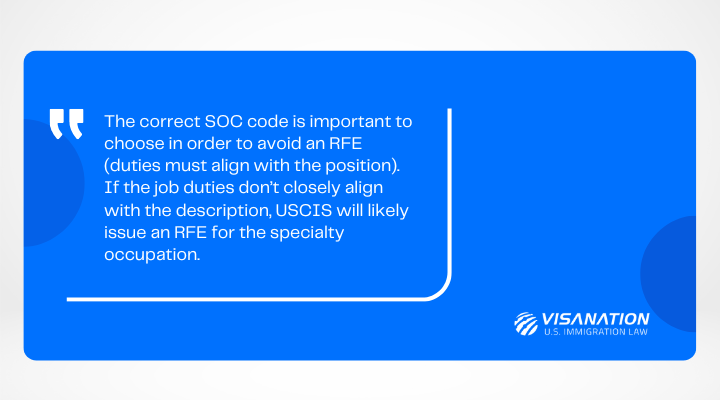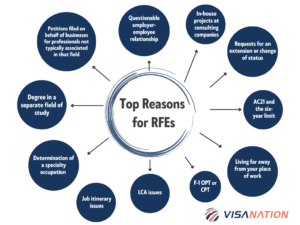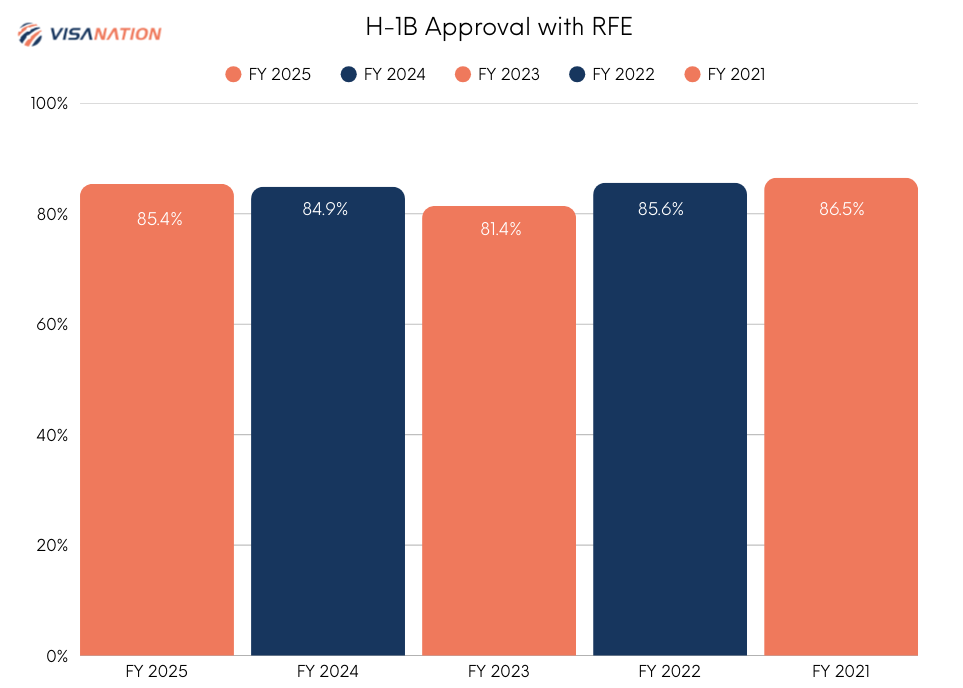Receiving an RFE from USCIS is not a reason to panic or automatically assume that your H-1B petition is rejected. Sometimes USCIS just needs additional information so that they can make a decision on your case. Due to the sensitive nature, it is always advised to have a qualified immigration attorney review and submit the RFE response to USCIS to ensure the highest chances of approval.
What is an H-1B RFE?
An RFE, otherwise known as a Request for Evidence, is an inquiry by the USCIS to request additional proof necessary to make a decision pertaining to your H-1B case. You can find out if you have an outstanding RFE by checking the status of your H-1B using the online case status tool or by receiving the request in the mail.
This information can be regarding the petitioner, beneficiary, or both, since the USCIS must see sufficient proof of an employer-employee relationship. From the time you receive the RFE, the USCIS guidelines state you have 84 days to submit the appropriate documents, with an additional 3 days of mailing time when residing inside the United States or 14 days when residing outside. However, the RFE will clearly state the deadline by which the requested initial or additional evidence must be submitted to USCIS.
You should take great care to ensure that you are thorough in answering all inquiries. Otherwise, you run the risk of delaying your case further or including information that may harm the outcome. For that reason, it’s highly recommended to navigate the process with the help of a specialized immigration attorney.

12 Top Reasons for Request for Evidence (RFE)
Wondering the best way to avoid getting an H-1B RFE? The USCIS uses a tool known as the Validation Instrument for Business Enterprises (VIBE). What VIBE does is use the information that’s commercially available to confirm information regarding the petitioning employer.
Some discrepancies may arise if there is a recent change of address, change of structure, or other mismatched information between the VIBE system and the H-1B petition. Therefore, you may receive an RFE requesting information like the employer’s Federal Tax ID Number, wage reports, lease agreement, financial statements, etc.
President Trump has signed a new proclamation introducing a $100,000 fee for new H-1B petitions. This change could impact employers and foreign workers planning to apply, but exclusions apply.Read our full article for more details

The most common H-1B RFE reasons include:
- Determination of a specialty occupation
- Petitions filed on behalf of businesses for professionals not typically associated with that field
- Degree in a separate or not closely related field of study
- Questionable employer-employee relationship
- Requests for an extension or change of status
- LCA issues
- Job itinerary issues
- Living far away from your place of work
- AC21 and the six-year limit
- F-1 OPT or CPT
- In-house projects at consulting companies
- Licensing requirements
If you are selected in the 2025-26 H-1B visa lottery, contact VisaNation attorneys for filing your H-1B petition.
1. Determination of a specialty occupation
H-1B visas are granted to individuals who are qualified workers in a “specialty occupation.” To qualify as such, you will be required to adhere to one of the following requirements:
The minimum requirement is typically a bachelor’s degree (or equivalent work experience) for the position. The position may also be so complex that it requires a degree. Other requirements may also apply. While these regulations are pretty much set in stone, the approval of a “specialty occupation” typically comes down to the judgment of the adjudicating officer. They look past the surface and may request paperwork like the beneficiary’s work experience, detailed job description, industry-wide practices, proposed salary, etc.
2. Petitions filed on behalf of businesses for professionals not typically associated with that field.
An RFE may be requested if a small business is filing an H-1B petition for an alien who possesses skills not commonly associated with that field. For example, a petition for a financial planner filed by a construction business. The USCIS may not see a correlation between the two and may be led to believe that the beneficiary will be placed in a position of less capacity and/or find other work when arriving. The major point for the employer to exhibit is that the beneficiary will be performing a role in a ‘specialty occupation’.
Learn more about the H-1B application process.
3. Degree in a separate field of study
Cases exist where an individual may have a bachelor’s degree, but it may not be in the same or a closely related field as the proposed position. If that’s the case, the RFE will request an explanation detailing how the degree relates to the position. Likewise, if the worker does not have a bachelor’s degree from the U.S. they may need to submit proof of the foreign degree equivalent. Proof of experience may also be required in the form of past employment letters or evaluations from official sources like a college, university, or qualified expert.
4. Questionable employer-employee relationship
As previously mentioned, the USCIS must see that an employer-employee relationship exists in order to approve an H-1B petition. The lines are often blurred when the sponsored worker is anticipated to be working off-site. When that’s the case, an RFE may request information that establishes the employer has the ability and right to control how, when, and where the worker performs the job. In past years, USCIS has targeted sub-contracting job placement firms with RFEs.
A questionable employer-employee relationship RFE response needs to show that the petitioning employer maintains the right to hire and fire the employee, controls the manner and means of the work performed, pays the wages of the employee (and provides benefits, if applicable), responsible for performance reviews of the employee, etc.
You usually need the employment agreement/contract between the employer and employee, and if the employee is placed on-site or remotely with a third-party end-client of the employer, then a copy of the Master Services Agreement and any addenda or extensions currently in effect showing that it’s an active client assignment. You particularly need to highlight the provisions stating that the contracting employer maintains full control of and pays the wages of its employees assigned to the end-client project.
5. Requests for an extension or change of status
If an H-1B petition is filed for an extension or change of status, sufficient documentation must be provided to demonstrate that the worker has maintained their current status by submitting pay statements or other documentation showing that they have been continuing to work under the terms of their nonimmigrant H-1B visa.
If you are selected in the 2025-26 H-1B visa lottery, contact VisaNation attorneys for filing your H-1B petition.
6. LCA issues
The H-1B Labor Condition Application (LCA) is an important part of your H-1B petition. If your employer skipped it, forgot to include it, or there is an issue in the one that was submitted, you will most likely receive an H-1B RFE from the USCIS. The main purpose of the LCA is to establish that the terms and conditions of the employment meet the H-1B requirements.
7. Job itinerary issues
If your employer is going to place you on a specific assignment that requires being at an end-client location, or involves working remotely, your H-1B petition must include an itinerary with a detailed description of your job duties, the duration of the job, the job requirements, the salary, benefits, hours worked, and the information about who is going to supervise you. If any of these items are not clear in the petition submitted by your employer, the USCIS may send you an RFE.
8. Living far away from your place of work
You may receive an H-1B RFE if you live in a place that is relatively far away from your office. Recently, the USCIS has been paying more attention to every detail in H-1B petitions. There have been some cases where people were asked to provide an explanation to justify why they lived so far from their place of work. The argument is that a beneficiary’s residential address and address of intended employment must be within a normal commuting area. This RFE can be resolved by providing a justifiable reason for living at such a distance.
9. AC21 and the six-year limit
You may receive an RFE concerning the AC21 and the six-year-limit if your employer failed to establish that you are eligible for AC21 benefits or eligible for an H-1B extension. This can happen if it appears that you have reached your six-year limit on your H-1B. The AC21 is the American Competitiveness Act in the Twenty-first Century Act of 2000. The Act allows H-1B employees to extend their stay beyond six years under two conditions:
- If the H-1B employee has a pending labor certification for an employment-based green card that was filed over a year ago.
- If both the labor certification and I-140 have been approved, but there is no available green card currently for the H-1B employee. To avoid receiving an RFE due to this, your employer may include copies of the approved labor certifications and/or I-140 to prove your eligibility for an extension. He or she may also provide your trip itineraries as well as entry and exit stamps to recapture the time you spent outside the United States.
In the above two scenarios, you are eligible for an extension beyond six years. However, the petition submitted by your employer must reflect at least one of those two instances to avoid receiving an RFE.
10. F-1 OPT or CPT
If you have had Optional Practical Training (OPT) or Curricular Practical Training (CPT) during your F-1 status, you may receive an RFE from the USCIS, especially if you had OPT or CPT more than once at each level of your education. For example, if you had CPT or OPT when doing your bachelor’s degree, you can only use it again when you get to the master’s level. If your petition reflects the use of any of these twice, you may get an H-1B RFE. For instance, you may get an RFE if you have two master’s degrees, and you used OPT/CPT during each of the master’s programs.
If you are selected in the 2025-26 H-1B visa lottery, contact VisaNation attorneys for filing your H-1B petition.
11. In-house projects at consulting companies
This type of RFE is more common for IT consulting companies. Many of these companies hire H-1B workers to work as developers, analysts, or engineers for clients’ in-house projects. These types of petitions often face hurdles as the USCIS will want the employer to prove that a legitimate H-1B employer-employee relationship exists. Suspicion sometimes arises if the H-1B employee will be stationed at the client’s worksite rather than the workplace of the petitioning employer. The USCIS will need additional documentation to be convinced that the arrangement isn’t just for a marginal project for the purpose of exploiting the H-1B system.
In addition to other general supporting evidence for your H-1B petition, your employer should provide documents that demonstrate that the in-house project is a specialty occupation and that there is a justifiable reason for the entire duration requested in the petition.
12. Licensing Requirements
Some skilled professions (architecture, engineering, accounting) might require certain licenses, for which USCIS might require proof. If the profession requires it, you should take the necessary steps to acquire the license.
Another RFE reason could be due to different information (i.e., address) in the VIBE (Validation Instrument for Business Enterprises) system used by USCIS. This is common when businesses are going through restructuring changes, and the VIBE system hasn’t been updated.
How to Respond to RFE for H-1B: Best Practices
Your first course of action anytime you receive correspondence from USCIS should be to share it with your immigration attorney. Keep these other considerations in mind:
- Read the RFE fully, and if you don’t understand something, ask your immigration attorney.
- Don’t make any rash decisions if you’ve received an RFE. It is not grounds to panic, but a tool used by the USCIS to learn more about your case.
- Do not answer the notice in parts. Answer the questions fully and completely the first time around, since the USCIS doesn’t typically send a second RFE if you happen to have missed a point.
- Double-check the mailing address and included documents.
- Submit your response before the deadline period ends. When you wait until the last minute, you run the risk of missing the deadline date, and then you’ll likely receive a denial, at which point you’ll have to file a motion to reopen the case. Of course, that’s not the ideal situation, but if you need help filing a motion to reopen the case, the VisaNation Law Group can aid you with that as well.
H-1B RFE Approval Rate
Based on a VisaNation analysis on USCIS data, the rate of approval with an RFE is 85.4% in FY 2025 (based on two quarters of data). This approval rate is slightly higher relative to the chances from prior years, such as 84.9% in FY 2024 and 81.4% in FY 2023.
The rate dramatically rose from a low of approximately 60% in 2018 to a peak of 86.5% in 2021 before dipping and then recovering.
Every alteration of the H-1B—be it a transfer, an extension, or an entirely new petition—requires an employer to send an I-129 form to the USCIS. This opens the case up to an RFE each time the petition is filed. In recent years, the H-1B RFE trend has fluctuated due to different administrations in office.

H-1B Approval Rates 2021-2025
If it’s any indication of what’s to come, H-1B approval rates through FY2025 (Q1 and Q2) were very high at 97.8%%, and the RFE rate was at a low 9.0%.
|
Fiscal Year |
H-1B Approvals |
Completion with RFE % |
Approved with RFE% |
|
2025 |
97.8% |
9.0% |
85.4% |
|
2024 |
98% |
8.2% |
84.9% |
|
2023 |
97.2% |
9.9% |
81.0% |
|
2022 |
98% |
9.6% |
85.5% |
|
2021 |
97.3% |
16.2% |
86.5% |
Source: USCIS, National Foundation for American Policy. Percentages are analyzed from USCIS H-1B Employer Data Hub. Note: The figures for Fiscal Year 2025 are preliminary, as the fiscal year is not yet complete. Final data may differ.
RFE vs NOID
RFEs are sometimes issued simply because a document was missing or an error occurred with the information entered into the petition. A Notice of Intent to Deny (or NOID) is a much more serious situation. NOIDs are issued when the officer in charge of evaluating your petition plans to deny your petition.
Because there is a difference between rejection and denial (rejection often happens after a technical error, such as omitted information or fee payments; denial usually takes place if you do not merit the visa), a NOID means that the officer does not think that you or your employer is qualified for the H-1B.
NOIDs are issued in order to avoid having petitioners re-file just to encounter the same fundamental problem. However, you can still save your case by presenting evidence or documentation that solves the issues raised in the NOID, much like you would for an RFE. The maximum response time for an NOID is 30 days.
Can a Beneficiary Respond Directly to an RFE?
No. Just the same way you are not allowed to sign an H-1B petition, you cannot respond to an H-1B RFE as an employee. The RFE is the responsibility of your petitioning employer. Though you can be made aware of the RFE by checking the status of your case online using the case receipt number of your petition.
RFE Response Time
According to USCIS, the RFE response times are as follows:
- Any response to an RFE must be completed in 84 days, plus an additional 3 (residing in the U.S.) or 14 (residing outside the U.S.) days to account for mailing time.
- A NOID or NOIR requires a response in 30 days, with the same allotment for mailing time as an RFE.
- Any Form I-290B received up to 30 calendar days from the date of the decision will be considered by USCIS before it takes any action.
What is the Probability That My H-1B Employer Will Receive an RFE?
The probability will depend on many factors, including the reasons we mentioned above, as well as the completeness of your case in its entirety. If you do receive one, don’t panic; you have 60 days to respond, so do not miss the deadline.
Be aware that you are also not immune to receiving an RFE if you have been in H-1B status for years and are extending it (with each I-129 filing, you run the risk of receiving an RFE). Regardless, no one is 100% safeguarded from receiving an RFE, so it is highly advised to seek an immigration attorney to handle your case.










